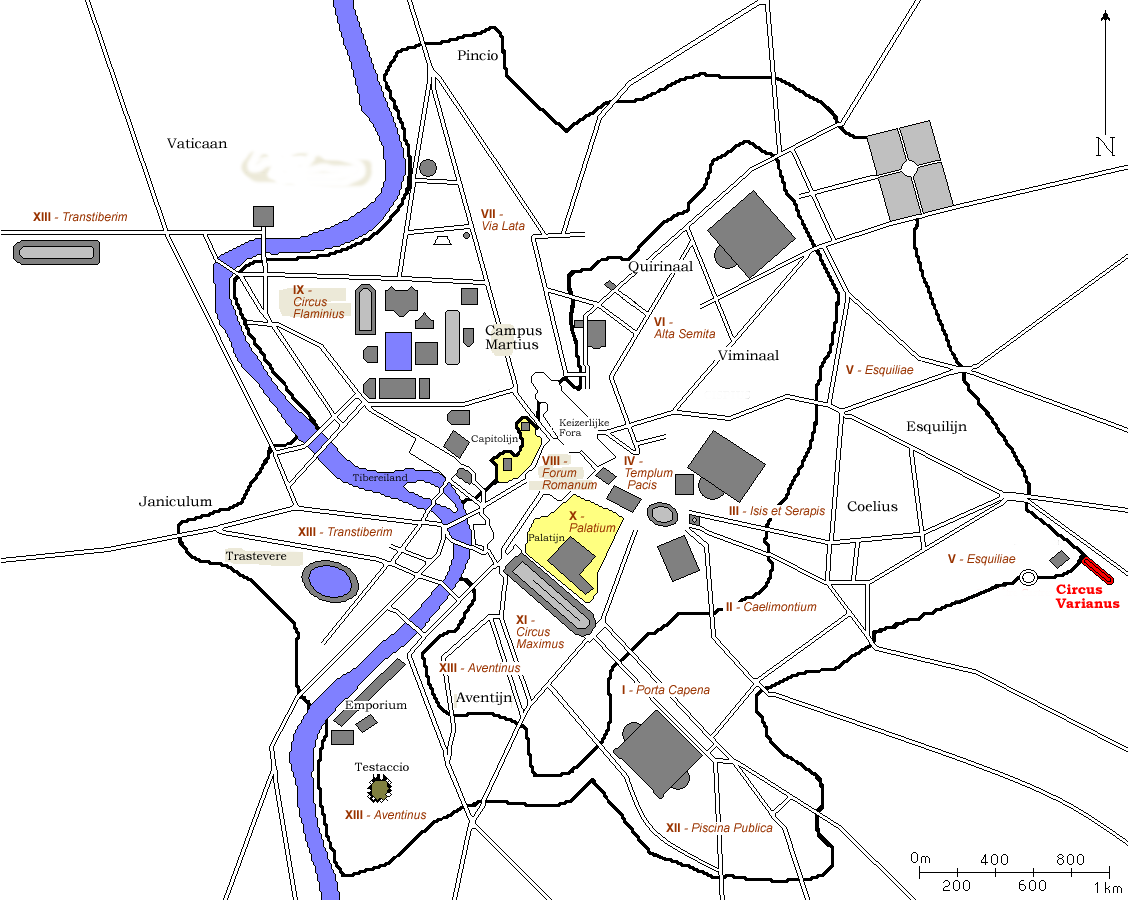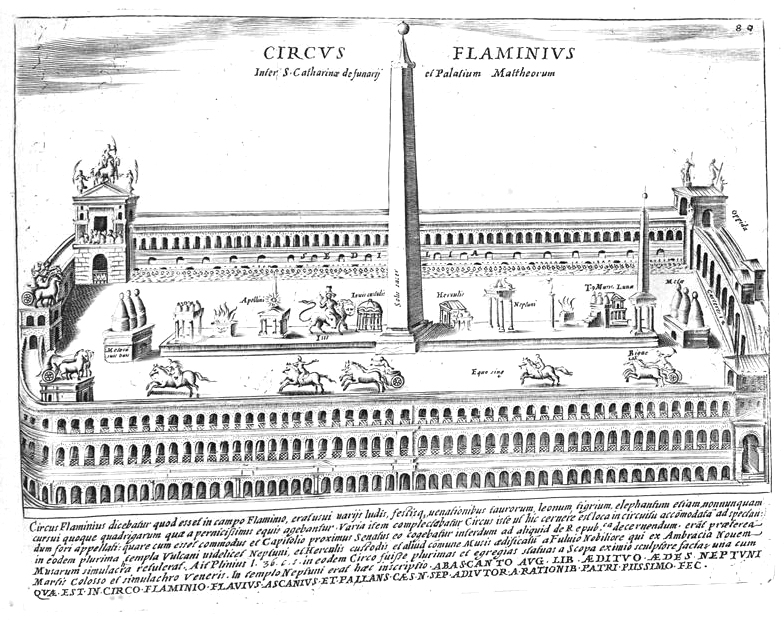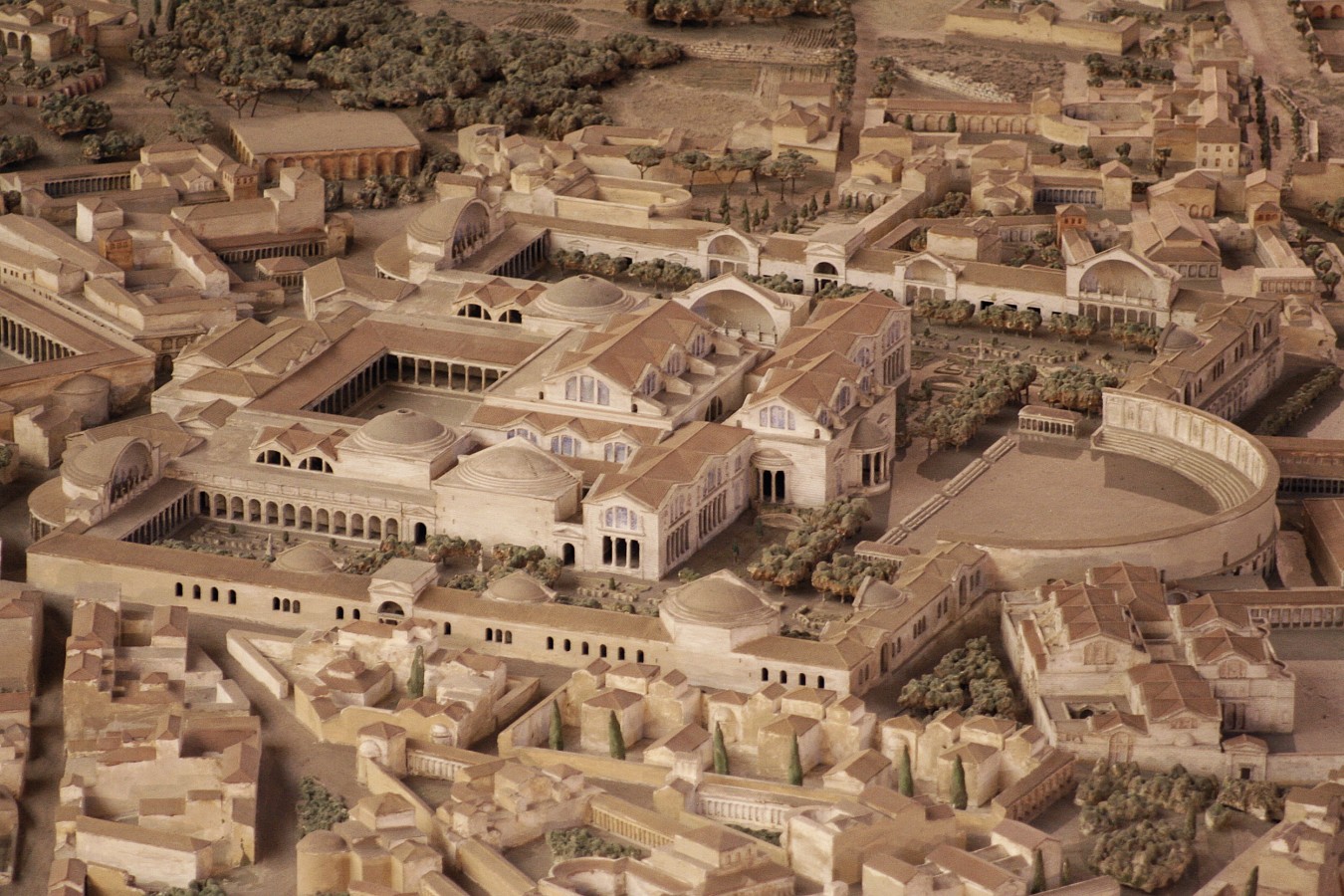|
List Of Ancient Monuments In Rome
This is a list of ancient monuments from Republican and Imperial periods in the city of Rome, Italy. Amphitheaters * Amphitheater of Caligula * Amphitheatrum Castrense * Amphitheater of Nero * Amphitheater of Statilius Taurus * Colosseum Baths * Baths of Agrippa * Baths of Caracalla * Baths of Commodus * Baths of Constantine * Baths of Decius * Baths of Diocletian * Baths of Licinius Sura * Baths of Nero and Alexander * Baths of Septimius Severus * Baths of Titus * Baths of Trajan (later misnamed the Baths of Domitian) Circuses * Circus Flaminius * Circus Maximus * Circus of Maxentius * Circus of Nero * Circus Varianus Gardens * Gardens of Lucullus * Gardens of Maecenas * Gardens of Sallust * Horti Aciliorum * Horti Agrippinae * Horti Caesaris * Horti Domitiae * Horti Lamiani * Horti Liciniani * Horti Lolliani * Horti Pompeiani * Horti Tauriani Porticoes * Porticus Aemilia * Porticus Deorum Consentium * Porticus of Livia * Porticus Octavia * Porticus Octaviae ... [...More Info...] [...Related Items...] OR: [Wikipedia] [Google] [Baidu] |
Roman Republic
The Roman Republic ( la, Res publica Romana ) was a form of government of Rome and the era of the classical Roman civilization when it was run through public representation of the Roman people. Beginning with the overthrow of the Roman Kingdom (traditionally dated to 509 BC) and ending in 27 BC with the establishment of the Roman Empire, Rome's control rapidly expanded during this period—from the city's immediate surroundings to hegemony over the entire Mediterranean world. Roman society under the Republic was primarily a cultural mix of Latin and Etruscan societies, as well as of Sabine, Oscan, and Greek cultural elements, which is especially visible in the Roman Pantheon. Its political organization developed, at around the same time as direct democracy in Ancient Greece, with collective and annual magistracies, overseen by a senate. The top magistrates were the two consuls, who had an extensive range of executive, legislative, judicial, military, and religious powers ... [...More Info...] [...Related Items...] OR: [Wikipedia] [Google] [Baidu] |
Baths Of Licinius Sura
The Baths of Licinius Sura or ''Thermae Suranae'' were a private ancient Roman bath complex built by Lucius Licinius Sura on the Aventine Hill (Regio XIII Aventinus) in Rome. They were restored during the short reign of Gordian III. The baths were damaged during the 410 sack of Rome by Alaric I, and again restored in 414. The baths probably served a more affluent community than the Baths of Caracalla, and were smaller and probably more elegant. Although now no ruins remain, their approximate location was: , and are partially shown on slab VII-14 of the ''Forma Urbis Romae'', numbered as fragment 21a by E. Rodríguez Almeida. Their location must have been in the immediate vicinity to the west of the church of Santa Prisca, near the Temple of Diana, with the arches of the Aqua Marcia which fed them, passing right along the site of the current church. On the ''Forma Urbis'', to the north of the baths there is also a temple of uncertain identification, perhaps the Temple of Luna or ... [...More Info...] [...Related Items...] OR: [Wikipedia] [Google] [Baidu] |
Gardens Of Maecenas
The Gardens of Maecenas, or ''Horti Maecenatis'', constituted the luxurious ancient Roman estate of Gaius Maecenas, an Augustan-era imperial advisor and patron of the arts. The property was among the first in Italy to emulate the style of Persian gardens. The walled villa, buildings, and gardens were located on the Esquiline Hill, atop the agger of the Servian Wall and its adjoining necropolis, as well as near the Horti Lamiani. History Lucullus started the fashion of building luxurious garden-palaces in the 1st century BC with the construction of his gardens on the Pincian Hill, soon followed by Sallust's gardens between the Quirinal, Viminal and Campus Martius, which were the largest and richest in the Roman world. In the 3rd century AD the total number of gardens (''horti'') occupied about a tenth of Rome and formed a green belt around the centre. The ''horti'' were a place of pleasure, almost a small palace, and offered the rich owner and his court the possibility of living ... [...More Info...] [...Related Items...] OR: [Wikipedia] [Google] [Baidu] |
Gardens Of Lucullus
The Gardens of Lucullus ( lat, Horti Lucullani) were the setting for an ancient villa on the Pincian Hill on the edge of Rome; they were laid out by Lucius Licinius Lucullus about 60 BC. The Villa Borghese gardens still cover of green on the site, now in the heart of Rome, above the Spanish Steps. History Lucullus The fabled gardens of Lucullus were among the most influential in the history of gardening. For introducing the Persian garden, Pompey mockingly nicknamed Lucullus "the Roman Xerxes", and Tubero called him "Xerxes in a toga". These comments demonstrate that it was well understood in Rome that this new luxury of gardening originated in Persia. Lucullus had firsthand experience of the Persian gardening style, in the satraps' gardens of Anatolia ( "Asia" to the Romans) and in Mesopotamia and Persia itself. As Plutarch pointed out, "Lucullus asthe first Roman who carried an army over Taurus, passed the Tigris, took and burnt the royal palaces of Asia in the sight of the ... [...More Info...] [...Related Items...] OR: [Wikipedia] [Google] [Baidu] |
Circus Varianus
Circus Varianus was a Roman circus, possibly started during the reign of Caracalla, residing in the palatial villa complex known as the Sessorium, beside the Amphitheatrum Castrense. This circus has been identified as the space in which Elagabalus raced horses under the family name of Varius, lending the site the name of "Circus Varianus." The remnants of the circus survive to the south of Porta Maggiore, next to the Aurelian Wall, near the church of Santa Croce in Gerusalemme. The dimensions of the circus measure 565 x 125 meters, just slightly smaller than the Circus Maximus (600 x 150 m). According to records in the 16th century, an obelisk was found at the site, measuring 9.25 meters tall. It had originally been located at the temple dedicated to Antinous at Antinoöpolis and was moved in the reign of Elagabalus. After being discovered, the obelisk was moved to the Palazzo Barberini in 1633,Richardson, pg. 272 from there to the Vatican Vatican may refer to: Vatican ... [...More Info...] [...Related Items...] OR: [Wikipedia] [Google] [Baidu] |
Circus Of Nero
The Circus of Nero or Circus of Caligula was a circus in ancient Rome, located mostly in the present-day Vatican City. Location and dimensions The accompanying plan shows an early interpretation of the relative locations of the circus and the medieval and current St. Peter's Basilica. The plan also suggests the dimensions of the circus relative to the Basilicas. A more modern interpretation differs in various respects: it maintains the central obelisk in the same position relative to the Basilicas, as in the accompanying plan, but rotates the entire circus about the obelisk, in a clockwise direction, about 170 degrees, so that the starting gates of the circus are now towards the east, and closer to the centre of Rome. The more modern interpretation also shows the circus as being much longer, relative to its width as compared to the early interpretation. See plan:Outline of St. Peter's, Old St. Peter's, and Circus of Nero. In both interpretations the circus building is centred on ... [...More Info...] [...Related Items...] OR: [Wikipedia] [Google] [Baidu] |
Circus Of Maxentius
The Circus of Maxentius (known until the 19th century as the Circus of Caracalla) is an ancient structure in Rome, Italy, part of a complex of buildings erected by emperor Maxentius on the Via Appia between AD 306 and 312. It is situated between the second and third miles of the Via Appia, between the basilica and catacombs of San Sebastiano and the imposing late republican tomb of Caecilia Metella, which dominates the hill that rises immediately to the east of the complex. It is part of the Appian Way Regional Park. Overview The Circus itself is the best preserved in the area of Rome, and is second only in size to the Circus Maximus in Rome. The only games recorded at the circus were its inaugural ones and these are generally thought to have been funerary in character. They would have been held in honour of Maxentius' son Valerius Romulus, who died in AD 309 at a very young age and who was probably interred in the adjacent cylindrical tomb (tomb of Romulus). The imperial box (p ... [...More Info...] [...Related Items...] OR: [Wikipedia] [Google] [Baidu] |
Circus Maximus
The Circus Maximus (Latin for "largest circus"; Italian: ''Circo Massimo'') is an ancient Roman chariot-racing stadium and mass entertainment venue in Rome, Italy. In the valley between the Aventine and Palatine hills, it was the first and largest stadium in ancient Rome and its later Empire. It measured in length and in width and could accommodate over 150,000 spectators. In its fully developed form, it became the model for circuses throughout the Roman Empire. The site is now a public park. Events and uses The Circus was Rome's largest venue for ''ludi'', public games connected to Roman religious festivals. ''Ludi'' were sponsored by leading Romans or the Roman state for the benefit of the Roman people (''populus Romanus'') and gods. Most were held annually or at annual intervals on the Roman calendar. Others might be given to fulfil a religious vow, such as the games in celebration of a triumph. In Roman tradition, the earliest triumphal ''ludi'' at the Circus were ... [...More Info...] [...Related Items...] OR: [Wikipedia] [Google] [Baidu] |
Circus Flaminius
The Circus Flaminius was a large, circular area in ancient Rome, located in the southern end of the Campus Martius near the Tiber River. It contained a small race-track used for obscure games, and various other buildings and monuments. It was "built", or sectioned off, by Gaius Flaminius in 221 BC. After Augustus divided the city into 14 administrative regions, the Circus Flaminius gave its name to Regio IX, which encompassed the Circus and all of the Campus Martius west of the Via Lata. Topography and structures In its early existence, the Circus was a loop, approximately 500 meters in length stretching across the Flaminian Fields (''Prata Flaminia''). Varro states that the actual Circus was built around the Fields, which were already a hallowed site for games by the time the Circus was laid in 220 BC. The '' ludi Taurei'' were hosted in the Fields since they were inaugurated by Rome's last king Lucius Tarquinius Superbus (d. 495 BC). During the 2nd century BC, this broad spa ... [...More Info...] [...Related Items...] OR: [Wikipedia] [Google] [Baidu] |
Baths Of Domitian
The Baths of Trajan ( it, Terme di Traiano) were a massive ''thermae'', a bathing and leisure complex, built in ancient Rome starting from 104 AD and dedicated during the ''kalendae'' of July in 109. Commissioned by Emperor Trajan, the complex of baths occupied space on the southern side of the Oppian Hill on the outskirts of what was then the main developed area of the city, although still inside the boundary of the Servian Wall. The architect of the complex is said to be Apollodorus of Damascus. The baths were being utilized mainly as a recreational and social center by Roman citizens, both men and women, as late as the early 5th century. The complex seems to have been deserted soon afterwards as a cemetery dated to the 5th century (which remained in use until the 7th century) has been found in front of the northeastern exedra. The baths were thus no longer in use at the time of the siege of Rome by the Ostrogoths in 537; with the destruction of the Roman aqueducts, all ''thermae' ... [...More Info...] [...Related Items...] OR: [Wikipedia] [Google] [Baidu] |
Baths Of Trajan
The Baths of Trajan ( it, Terme di Traiano) were a massive ''thermae'', a bathing and leisure complex, built in ancient Rome starting from 104 AD and dedicated during the ''kalendae'' of July in 109. Commissioned by Emperor Trajan, the complex of baths occupied space on the southern side of the Oppian Hill on the outskirts of what was then the main developed area of the city, although still inside the boundary of the Servian Wall. The architect of the complex is said to be Apollodorus of Damascus. The baths were being utilized mainly as a recreational and social center by Roman citizens, both men and women, as late as the early 5th century. The complex seems to have been deserted soon afterwards as a cemetery dated to the 5th century (which remained in use until the 7th century) has been found in front of the northeastern exedra. The baths were thus no longer in use at the time of the siege of Rome by the Ostrogoths in 537; with the destruction of the Roman aqueducts, all ''thermae' ... [...More Info...] [...Related Items...] OR: [Wikipedia] [Google] [Baidu] |







